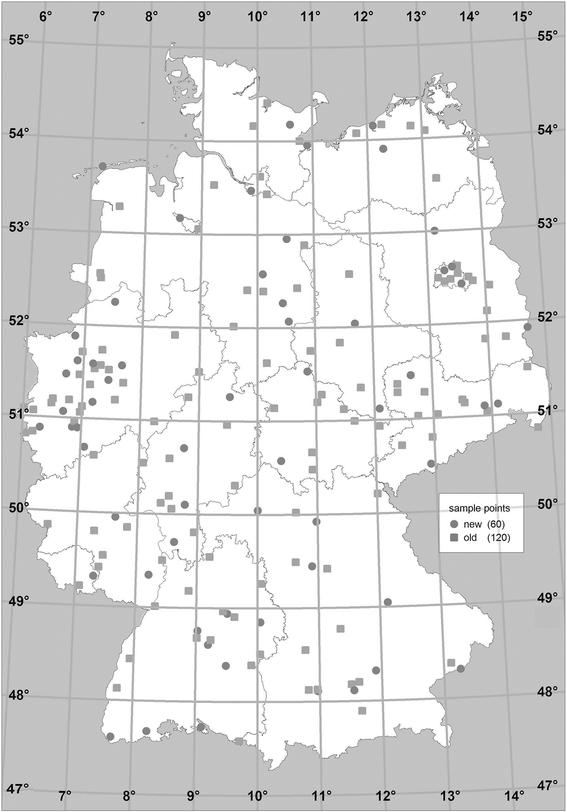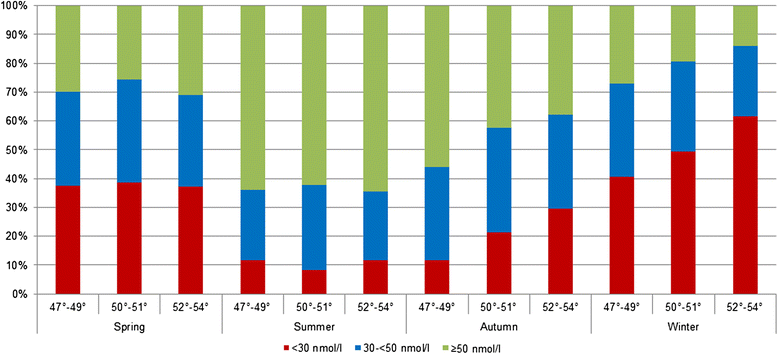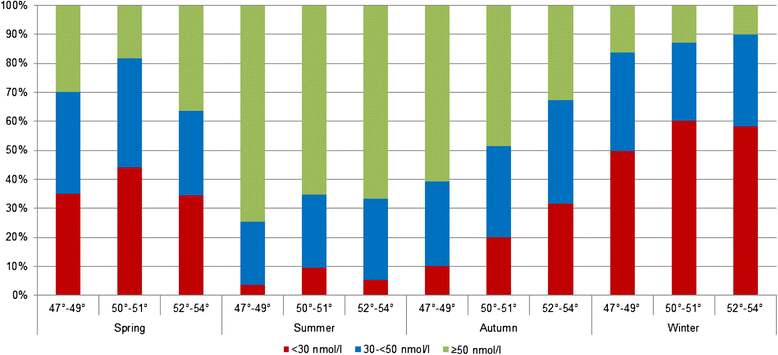Vitamin D status among adults in Germany--results from the German Health Interview and Examination Survey for Adults (DEGS1)
- PMID: 26162848
- PMCID: PMC4499202
- DOI: 10.1186/s12889-015-2016-7
Vitamin D status among adults in Germany--results from the German Health Interview and Examination Survey for Adults (DEGS1)
Abstract
Background: In 1998, more than half of the adult population in Germany had serum 25-hydroxy-vitamin-D [25(OH)D] levels below the common threshold of 50 nmol/l. Since then, there has been a lot of attention for vitamin D in the scientific community, the media and the general population and serum 25(OH)D levels may have increased as a consequence. With data from the 'German Health Interview and Examination Survey for Adults' (DEGS1) the current situation of vitamin D status can be analysed.
Methods: DEGS1, a national health survey among adults in Germany conducted by the Robert Koch Institute between 2008 and 2011, included 6,995 persons with available serum 25(OH)D levels. We calculated the proportion of participants with serum 25(OH)D levels <30 nmol/l, 30- < 50 nmol/l and > =50 nmol/l overall and according to age, season and latitude of residence as well as percentiles of serum 25(OH)D according to month of examination. Determinants of vitamin D status were analysed with multiple linear regression models.
Results: Mean serum 25(OH)D level was 45.6 nmol/l with no significant sex differences (p = 0.47). 61.6% of the participants had serum 25(OH)D levels <50 nmol/l, 30.2% had levels <30 nmol/l. During summer, half of the participants had levels > =50 nmol/l, during winter time, 25% of the participants had levels <30 nmol/l. A significant latitudinal gradient was observed in autumn for men and in winter for women. In multiple linear regression analyses, examination during winter time, residing in northern latitude, non-use of vitamin D supplements, low sport activity, high Body Mass Index (BMI) and high media consumption were independently and significantly associated with lower serum 25(OH)D levels in both sexes. In addition, among women, significant associations with lower 25(OH)D levels were observed for older age and lower socio-economic status, among men, for low vitamin D intake and more residential traffic.
Conclusions: Serum 25(OH)D levels below the threshold of 50 nmol/l are still common among adults in Germany, especially during winter and spring and in higher latitudes. Potentially modifiable factors of poorer vitamin D status are higher BMI, lack of sport activity and high media use.
Figures
Similar articles
-
Vitamin D status and health correlates among German adults.Eur J Clin Nutr. 2008 Sep;62(9):1079-89. doi: 10.1038/sj.ejcn.1602825. Epub 2007 May 30. Eur J Clin Nutr. 2008. PMID: 17538533
-
Vitamin D status and its determinants during autumn in children at northern latitudes: a cross-sectional analysis from the optimal well-being, development and health for Danish children through a healthy New Nordic Diet (OPUS) School Meal Study.Br J Nutr. 2016 Jan 28;115(2):239-50. doi: 10.1017/S000711451500433X. Epub 2015 Nov 13. Br J Nutr. 2016. PMID: 26563915 Clinical Trial.
-
25-Hydroxyvitamin D in Canadian adults: biological, environmental, and behavioral correlates.Osteoporos Int. 2011 May;22(5):1389-99. doi: 10.1007/s00198-010-1362-7. Epub 2010 Aug 21. Osteoporos Int. 2011. PMID: 20730415 Free PMC article.
-
Relative importance of summer sun exposure, vitamin D intake, and genes to vitamin D status in Dutch older adults: The B-PROOF study.J Steroid Biochem Mol Biol. 2016 Nov;164:168-176. doi: 10.1016/j.jsbmb.2015.08.008. Epub 2015 Aug 11. J Steroid Biochem Mol Biol. 2016. PMID: 26275945 Review.
-
Are the current Australian sun exposure guidelines effective in maintaining adequate levels of 25-hydroxyvitamin D?J Steroid Biochem Mol Biol. 2016 Jan;155(Pt B):264-70. doi: 10.1016/j.jsbmb.2015.03.007. Epub 2015 Mar 20. J Steroid Biochem Mol Biol. 2016. PMID: 25797374 Review.
Cited by
-
Characterization of the metabolic profile associated with serum 25-hydroxyvitamin D: a cross-sectional analysis in population-based data.Int J Epidemiol. 2016 Oct;45(5):1469-1481. doi: 10.1093/ije/dyw222. Epub 2016 Sep 7. Int J Epidemiol. 2016. PMID: 27605587 Free PMC article.
-
The Impact of Vitamin D Level on the Severity and Outcome of Hospitalized Patients with COVID-19 Disease.Int J Gen Med. 2022 Jan 7;15:343-352. doi: 10.2147/IJGM.S346169. eCollection 2022. Int J Gen Med. 2022. PMID: 35027842 Free PMC article.
-
Nutritional status of flexitarians compared to vegans and omnivores - a cross-sectional pilot study.BMC Nutr. 2023 Nov 28;9(1):140. doi: 10.1186/s40795-023-00799-6. BMC Nutr. 2023. PMID: 38017527 Free PMC article.
-
Predictors of sun protection behaviours and sunburn among Australian adolescents.BMC Public Health. 2016 Jul 13;16:565. doi: 10.1186/s12889-016-3197-4. BMC Public Health. 2016. PMID: 27411518 Free PMC article.
-
A Critical Appraisal of Strategies to Optimize Vitamin D Status in Germany, a Population with a Western Diet.Nutrients. 2019 Nov 6;11(11):2682. doi: 10.3390/nu11112682. Nutrients. 2019. PMID: 31698703 Free PMC article.
References
-
- Bellach BM, Knopf H, Thefeld W. The German Health Survey. 1997/98. Gesundheitswesen. 1998;60 Suppl 2:S59–68. - PubMed
-
- Bouillon R. Vitamin D: from photosynthesis, metabolism, and action to clinical applications. In: DeGroot LJ, Jameson JL, editors. Endocrinology. Philadelphia: Saunders, W.B; 2001. pp. 1009–1028.
MeSH terms
Substances
LinkOut - more resources
Full Text Sources
Other Literature Sources
Medical





